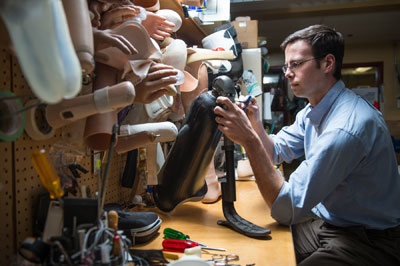Breakthrough in prosthesis research hinges on human caring
Author: Communications
Posted on Oct 19, 2015
Category: UNB Fredericton
 How much do people care? It’s somewhat of a quirky question, but it’s something Jon Sensinger and his team at the Institute of Biomedical Engineering at the University of New Brunswick wanted to answer.
How much do people care? It’s somewhat of a quirky question, but it’s something Jon Sensinger and his team at the Institute of Biomedical Engineering at the University of New Brunswick wanted to answer.
The group spent a year and a half studying how much people care when making mistakes and were surprised when they were able to answer the question with a calculated and numerical response: people care to the 1.7th power for different types of reaching tasks and levels of error.
The topic might seem unusual to some, but in reality the findings are incredibly important to the institute’s research. By answering that question the team is able to develop better controllers for amputees - controllers that are on the same page as the people using them in regards to the choices it should make.
“So let’s say that I’ve come up and I’ve developed a new controller,” said Sensinger, the associate director of the institute. “It’s supposed to do a really good job and it does a really good job, nine times out of 10. But that 10th time it’s really wrong. You told the arm to go here and the old controller, let’s say sometimes it would go (in the approximate area). The new controller is spot-on nine times out of 10 but one time it ends up (in completely the wrong spot). So is that controller better than the old one that was usually worse, but was never really bad?”
The research was conducted by measuring data from 24 able-bodied subjects using myoelectric control.
The institute, which offered Canada’s first graduate program in biomedical engineering, studies myoelectric limbs, which move through the generation of electrical signals when a user thinks about moving the limb.
Sensinger said the institute is researching how to fine-tune that process. He compared the method to stepping on the gas pedal of a car and listening to the engine rev.
“It’s similar to listening to the rumble of a car. It’s not a direct signal, it’s an estimate. It tends to be a noisy estimate so a lot of the research we do is how to get a more precise guess at what the person is trying to do when they’re controlling their arm.”
Conducting accurate research required the team to develop an abstraction that could be applied to future algorithms, rather than conducting a survey with their patients. It was deeper than asking a this-or-that question, Sensinger said, in order to discover which controller was better.
“So in order to answer that question we need to know how much you care about the size of the error, which is a general question of how much you care about anything of magnitude - so any trade-offs that you have to make in life. Do you care more about big mistakes versus small mistakes?
“We came up with an abstraction of how you compensate as a function of error, and then we were able to fit potential, or candidate, cost functions to those compensations and say, ‘Well if you happen to care this way then here’s how you would have compensated as I changed the setting, and if you cared this way, then here’s how you would have compensated.’”
The work was conducted in its entirety at UNB, which is a world-leader in powered prosthetic research . Sensinger said the research was aided by the institute’s director, Kevin Englehart, and Adrian Aleman-Zapata, a 2014 Mitacs summer intern. All three are authors on a manuscript of the research, entitled “Do Cost Functions for Tracking Error Generalize across Tasks with Different Noise Levels?,” which was published on Aug. 27, 2015.
The research team found an abstraction that states how people cared corresponds with how they compensated, which Sensinger said was in and of itself useful.
“But one of the exciting things was that the way that you care or compensated actually is very similar to when you do different tasks that aren’t using prosthesis control,” he said.
The Atlantic Clinic for Upper Limb Prosthetics, located within the Institute of Biomedical Engineering, sees 150 patients per year on average, according to Sensinger.
Sensinger and two former students of the institute, along with another researcher, have also formed a company that is developing more accurate and intuitive controllers. Those controllers focus on thinking about the actions rather than using Morse code and have already hit the market. More than 100 people have been fitted for these new controllers.
“In the broad sense of developing new controllers that are making an impact in peoples’ lives, that’s what we’re well known for at the institute scientifically.”
